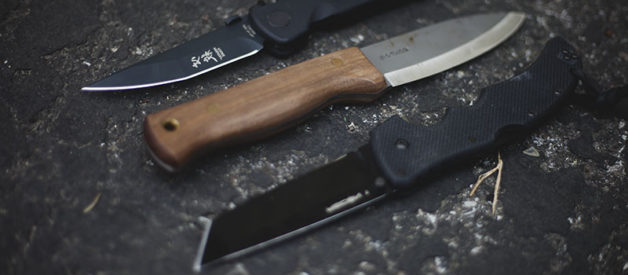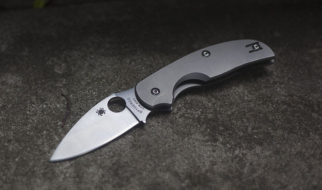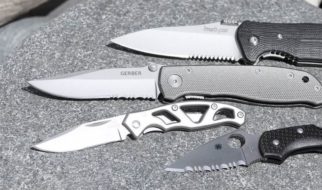There are many knife blades types on the market. They come in all kinds of shapes, sizes and are made from a variety of materials. In this article, I will talk about some of the more common blade shapes you will run into. There are several alterations to most of these, as many manufacturers try to put their unique spin on things. But ultimately, they will all be rooted in the basic designs listed below.
There are knife blade shapes for just about any job, and depending on the task, some will work better than others. When choosing the best everyday carry knife for your particular needs, give consideration to exactly what you will be using your blade for the majority of the time. Then, make your choice based on that information.
Normal Blades
Also sometimes called a simple or straight-back blade, this blade has a curved edge and a straight spine. The straight spine is not sharp and therefore lets you use your non-holding hand to apply extra pressure. In doing so, you increase the force of the cut.
These knife blade types are very strong, making them perfect for heavier work like cutting roots or thick rope. Because of the extra pressure that can be applied, normal blades are very useful for chopping and slicing. These types of knife are also good to own if you’re still learning and trying to improve your sharpening skills.
Drop Point Blades
 Like a normal blade, a drop point blade has a curved edge. The spine, however, instead of being perfectly straight, starts dropping towards the edge as it gets closer to the tip.
Like a normal blade, a drop point blade has a curved edge. The spine, however, instead of being perfectly straight, starts dropping towards the edge as it gets closer to the tip.
This type of knife blades is durable with a very robust tip. It is easy to control both when cutting and piercing. Because this shape is useful in most situations, it makes for an ideal everyday carry. It is then no surprise that a good number of EDC knives opt for a drop point blade.
Spear Point Blades
 Symmetry is the name of the game with a spear point blade. Both edges start to curve in the same spot to form a tip that lies on the center line of the blade.
Symmetry is the name of the game with a spear point blade. Both edges start to curve in the same spot to form a tip that lies on the center line of the blade.
These grinds are typically, though not always, double-edged and are ideal for piercing and thrusting. The design is, however, not very practical and as such rarely used for EDC knives. A spear point is well suited for fighting, tactical or throwing knives.
Needle Point Blades
 Like the spear point, a needle point blade is also symmetrical. The difference is the edges taper much more sharply to form a needle-like tip.
Like the spear point, a needle point blade is also symmetrical. The difference is the edges taper much more sharply to form a needle-like tip.
Because of how thin it is, a spear point blade is not very durable. It is, however, very effective for penetrating or piercing. You’ll usually find this type of blade on daggers designed for close quarters combat.
Spey Point Blades
A spey point blade has a mostly straight edge that suddenly curves in near the tip. Similarly, the spine is also straight for almost its entire length and only angles down sharply towards the tip at the very end of the blade.
The resulting tip is somewhat obtuse, making it hard to pierce anything by accident. Because of this feature, spey point blades are perfect for skinning and dressing animals, making them common in trapper knives.
Pen Blades
The pen blade is a cousin of the spear point. Both the edge and spine shapes are symmetrical and curve towards the tip, but at a more gradual pace than on a spear point.
Smaller pocket knives often use this shape. Most commonly, only one side of the blade is sharp.
Tanto
 Inspired by Japanese daggers and swords, a tanto blade provides excellent strength. Sometimes also called a chisel point blade, this profile has a single edge that remains straight until just short of the tip. The edge then suddenly angles up to meet the spine. The spine is straight for the blade’s entire length.
Inspired by Japanese daggers and swords, a tanto blade provides excellent strength. Sometimes also called a chisel point blade, this profile has a single edge that remains straight until just short of the tip. The edge then suddenly angles up to meet the spine. The spine is straight for the blade’s entire length.
Because of their strength, tanto blades are commonly found on everyday carry and tactical knives. While the shape of the tip is not ideal for piercing, its durability more than makes up for it. Do note that because of their tip shape, tanto blades are not the easiest to sharpen and are therefore not the best choice for beginners.
Clip Point Blades
 The shape of a clip point blade comes from “clipping” (removing) a section off the back of a normal or simple blade. The “clipped” section is usually curved away from the blade, but can also sometimes be straight. In some cases, it may also have an edge.
The shape of a clip point blade comes from “clipping” (removing) a section off the back of a normal or simple blade. The “clipped” section is usually curved away from the blade, but can also sometimes be straight. In some cases, it may also have an edge.
This thin tip on this grind makes it easy to cut and slice in tighter spots and gives the user a bit more control. This design is fairly common on a wide range of blades, from fighting and pocket knives to large hunting knives. The American Bowie knife is perhaps one of most famous examples of a clip point blade.
Trailing Point Blades
 The trailing point blade has a visually distinct edge that curves towards a spine which also curves in the same direction. The two sides meet to form a tip that will usually be located higher than the handle. That is where the name “trailing point” comes from.
The trailing point blade has a visually distinct edge that curves towards a spine which also curves in the same direction. The two sides meet to form a tip that will usually be located higher than the handle. That is where the name “trailing point” comes from.
The long curve of the edge makes these knife blade shapes ideal for slicing and slashing. It is also well suited for making long, even cuts. Compared to other shapes, the trailing point can be quite lightweight. It is commonly used on filet knives.
Sheepsfoot Blades
 Almost the opposite of the normal or straight-back blade, the sheepsfoot has an entirely straight edge and a spine that is also straight for most of its length, but curves towards the edge as it nears the tip. As its name suggests, this blade design was originally used for trimming sheep hooves.
Almost the opposite of the normal or straight-back blade, the sheepsfoot has an entirely straight edge and a spine that is also straight for most of its length, but curves towards the edge as it nears the tip. As its name suggests, this blade design was originally used for trimming sheep hooves.
Sheepsfoot blades are somewhat underutilized. They can be an excellent teaching knife. They are great for beginner wood carving, and because of its straight edge, this design is also perfect for learning knife sharpening.
These ten knife blade types are the ones you will most commonly find on the market. As might be apparent from my best EDC knife list, my personal favorites are the drop point and simple blades. They are strong, versatile and easy to maintain.
Remember that no one knife blade shape is ideal for all uses. Before you decide in which to invest in, consider what you will be using the knife for the most, and let that guide your decision. I also encourage you to take a look at my guide on how to choose an EDC knife for additional tips on picking your perfect knife.



